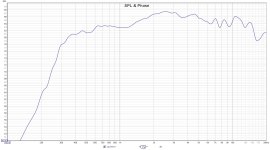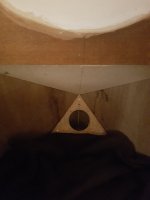But Olson's design (and your recommendation of the Fane) is based on going full range, no? If you just want to use it for lower frequencies, say from 750Hz down with small horn for above that plunked on top, wouldn't a different driver be better ?Also, for the times, Olson's was SOTA and it still would be if accurately replicated today, but in general we have a much different signal chain, which requires a significantly different driver design. If wanting to use his basic design, then do a T/S designed one using this driver as the closest I'm aware of the LC-1A and adjust its internal dims, if any.
Re: the baffle step, I was asking about it because with the corner horn I imagine output from the driver front wraping around to meet what is coming along the wall from the corner. I wouldn't have a clue as to how to go about designing so everything sums just right.
Last edited:
Nowadays, yes, but specs is specs, so if the woofer has the same basic (Fs, Vas, Qts) specs......... which back then was pretty much the case, though of course not listed as such. Note too that the driver is pistonic in the Fs - Vc dia. frequency, so Xoing the Fane for 750 Hz will work, though of course better to find a similar spec woofer with more Xmax.
Hmm, OK I thought these were two different Qs, but if related to a corner horn, then there's normally no BSC required, only any eigenmodes off any parallel walls causing ripples in its response, which there wouldn't be with a typical corner horn since it's normally at an angle, ditto any floor ceiling ones nearby if the baffle is canted > ~12 deg..
Hmm, OK I thought these were two different Qs, but if related to a corner horn, then there's normally no BSC required, only any eigenmodes off any parallel walls causing ripples in its response, which there wouldn't be with a typical corner horn since it's normally at an angle, ditto any floor ceiling ones nearby if the baffle is canted > ~12 deg..
Thanks ! Yes, all the questions were with corner horn in mind so it wouldn't go too far off centre with the OP's interest in a LF horn.
Glad to hear about the no BSC requirement though now I have to look up eigenmodes.
I've never seen a corner horn with canted baffle. I guess the alternative to that would be sloping floor and ceiling? : )
Glad to hear about the no BSC requirement though now I have to look up eigenmodes.
I've never seen a corner horn with canted baffle. I guess the alternative to that would be sloping floor and ceiling? : )
You're welcome! Actually just one needs to slope > 12 deg or both that total it.
eigenmodes = standing waves, so FWIW easiest for me to view them like in an open pipe or plucked string.
eigenmodes = standing waves, so FWIW easiest for me to view them like in an open pipe or plucked string.
Do you mean as in , back at the top , back at the bottom, with centre forward like > (for one example) or reverse like < ( for another example) ?or both that total it.
Basically any combination of non parallel spaces that total >12 deg, so yes if I understand you.
Looks like time to make a better defined dimensional drawing of that Olson horn. Where the low pass filter cavity and the filter ports are concerned , it will be a challenge to figure out how to reconcile the top view with the side view. I know somebody who knows a guy. Time to see what info on the street there is. . . . . . .
Well, none apparently. I tried contacting someone I knew who was friends with someone that had built the Olson horn but he's changed email and I won't pursue it. As the OP here hasn't expressed interest in the corner horn any further I'll post on the original thread if I find anything else. Thanks.
Maybe a person could attempt to replicate it in hornresp and gain control of the factors that affect its performance.
Maybe a person could attempt to replicate it in hornresp and gain control of the factors that affect its performance.
Would you mind if I copy and post this to the Olson Corner Horn thread?
Following some input from people with far more knowledge than I have on horns, I'm considering changing the main horn from vertical and would appreciate feedback.
This potentially can allow me to simplify from 4 way to 3 way. I'll aim to use Celestion axi2050 c/w LeCleach horn and JBL 2405 as shown in the drawing.

I'll be looking to crossover to Celestion @ 500 Hz & JBL 2405 @ ~ 7kHz
Below is a quick measure of Celestion.

If this is feasible, one itch is to go to a passive crossover, as opposed to active. Again, all comments welcome.
This potentially can allow me to simplify from 4 way to 3 way. I'll aim to use Celestion axi2050 c/w LeCleach horn and JBL 2405 as shown in the drawing.

I'll be looking to crossover to Celestion @ 500 Hz & JBL 2405 @ ~ 7kHz
Below is a quick measure of Celestion.

If this is feasible, one itch is to go to a passive crossover, as opposed to active. Again, all comments welcome.
Rumour has it Axi2050 goes deep but not something to use as a tweeter.
Passive is fine, I like 1st order over 2nd order. I have been testing so many drivers that now I don’t care anymore. Just out cap on it and call it a day. Maybe a coil if using a tweeter.
GR research says use a tweeter that starts as low as possible. Almost down to 1000Hz would be good. It prevents problems with cancellations with the lower midrange. So maybe Ixnay on the 2405 and have a look at JMLC 1000 or similar. I Am not sure if this is applicable on horns yet, as I have not done the tests myself yet. Building a slider for ny tweeter horns to physically time align them.
Passive is fine, I like 1st order over 2nd order. I have been testing so many drivers that now I don’t care anymore. Just out cap on it and call it a day. Maybe a coil if using a tweeter.
GR research says use a tweeter that starts as low as possible. Almost down to 1000Hz would be good. It prevents problems with cancellations with the lower midrange. So maybe Ixnay on the 2405 and have a look at JMLC 1000 or similar. I Am not sure if this is applicable on horns yet, as I have not done the tests myself yet. Building a slider for ny tweeter horns to physically time align them.
I was worried about compression drivers as a whole when I first got into horns... My Axi2050 does fine as a tweeter and a midrange. I've speculated that the dry decay of the tweeter in the HF might be something unfamiliar to listeners. My measurements show it running up to 20khz so not sure what all the fuss is... in particular, lesser decays equates to higher accuracy. I listen to Jazz/Rap/Edm/Rock etc etc.... no complaints... its possible there isn't a 2" exit driver with a smoother fr above 10khz.
If the people commenting on the Axi as tweeter aren't voicing the driver in a neutral way.....what weight does their opinion hold? DSP is going to be required to level out sensitivity. So if they mean the Axi isnt the best tweeter for passive eq, or no eq.... theres probably truth in that statement
If the people commenting on the Axi as tweeter aren't voicing the driver in a neutral way.....what weight does their opinion hold? DSP is going to be required to level out sensitivity. So if they mean the Axi isnt the best tweeter for passive eq, or no eq.... theres probably truth in that statement
Last edited:
What does this mean? Which one is the main horn?I'm considering changing the main horn from vertical
@Rewind & @camplo thanks for your comments and video link. I guess I need to put the legwork in and build, measure & listen
@AllenB aologies for not being clear. My current set up is shown in post 122
Current vertical horn covers approx 50 to 250 hz using a 15" driver. This is the horn that I'm considering turning from vertical to horizontal.
@AllenB aologies for not being clear. My current set up is shown in post 122
Current vertical horn covers approx 50 to 250 hz using a 15" driver. This is the horn that I'm considering turning from vertical to horizontal.
Last edited:
- Home
- Loudspeakers
- Multi-Way
- A 4-way Horn speaker

